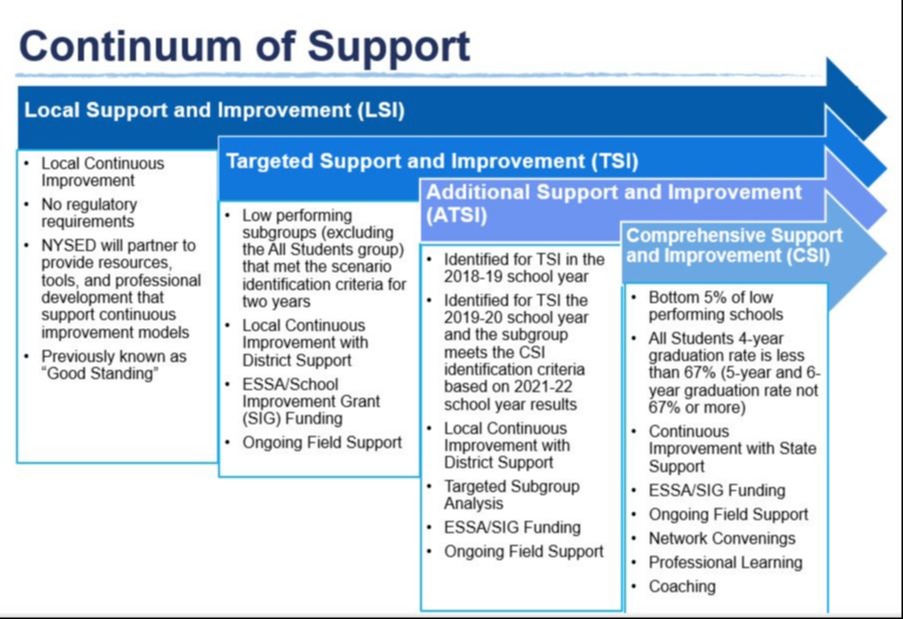Accountability Plans and Reports
Understanding Accountability
The Every Student Succeeds Act, or ESSA, the main federal law for K-12 public education, aims to ensure all children get a quality education. The law requires that states hold public schools accountable for how students achieve. ESSA does give states flexibility—their accountability systems can measure much more than just test scores.
The New York State Education Department (NYSED) has established a new set of indicators to measure school performance. NYSED developed these indicators with the input of thousands of people statewide—parents, educators, and experts. The new indicators include:
student academic achievement;
student growth and school progress;
progress of English language learners;
chronic absenteeism; and
for high schools, graduation rates and preparing students for college, career and civic engagement.
Accountability Designations
Schools and districts earned a score for all students and for student subgroups. Such subgroups include members of racial and ethnic groups, low-income students, students with disabilities and English language learners. These levels are used to determine whether a district is a Good Standing District or a Target District and whether a school is in Good Standing or identified for Comprehensive Support and Improvement or Targeted Support and Improvement.
Buffalo Public Schools identified as TSI for 2019-20
All Buffalo Public Schools are required to provide plans and reports to the New York State Education Department (NYSED) or the district.
Archive of Closed Schools
Receivership Schools And Reports
Three Buffalo Public Schools are currently in Receivership:
037 Marva J. Daniel Futures Prep School (Cohort 1)
097 Harvey Austin School (Cohort 1)
131 The Academy School (Cohort 2)
How are schools identified as Receivership schools?
Beginning with the 2018-19 school year the placement of a school under superintendent Receivership is a consequence of it being identified for Comprehensive Support and Improvement (CSI) based on the state’s new accountability system under the Every Student Succeeds Act (ESSA) plan. A school was identified for Receivership in 2018-19 if it was in Priority School status for the 2017-18 school year and was designated as CSI for the 2018-19 school year.
What is the difference between Cohort 1 and Cohort 2 schools?
Cohort 1 schools are those that were in Receivership status during the 2017-18 school year and were re-identified for Receivership in the 2018-19 school year based on the 2017-18 school year results.
Cohort 2 schools are those that were newly identified as Receivership schools in the 2018-19 school year.
Both Cohort 1 and Cohort 2 schools have been designated as Struggling Schools beginning with the 2018-19 school year.
Newly identified Receivership schools (Cohort 2) must make Demonstrable Improvement (DI) beginning in 2020-21, and annually thereafter, or they will be placed in Independent Receivership.
Re-identified Receivership schools (Cohort 1) must continue to annually make DI to avoid being placed in Independent Receivership

